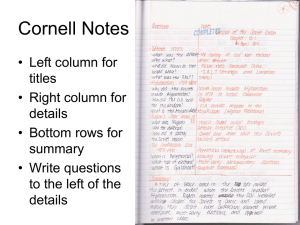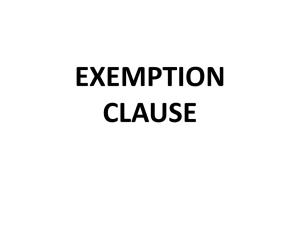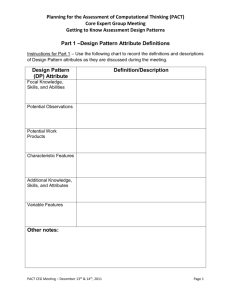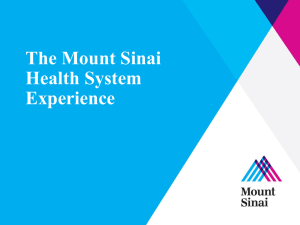people - School of Computing
advertisement
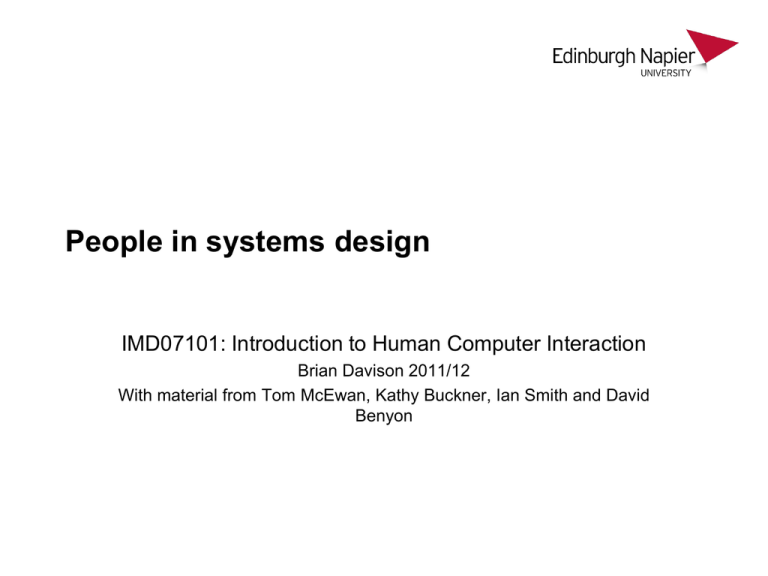
People in systems design IMD07101: Introduction to Human Computer Interaction Brian Davison 2011/12 With material from Tom McEwan, Kathy Buckner, Ian Smith and David Benyon Agenda • • • • • • • • Legal Social Ethical and Professional Issues (LSEPI) PACT framework Data collection techniques Short break Contexts Activities Mental models PACT analysis – Scenarios – Personas LSEPI • Legal – Laws about data protection, processes, illegal digital material in different jurisdictions (in a global Internet) • Social – It’s counterproductive to be anti-social – IT makes new social possibilities • Ethical – In many ways a reflection of Legal and Social – Moral issues • Professional – All of the above – avoid doing the wrong things – Ensure you do (all) the right things Ethics & codes of conduct • “Moral principles governing or influencing conduct” – Oxford English Dictionary definition of ethics • Practitioners are governed by professional codes of conduct. eg – – – – BCS, The Chartered Institute for IT British Psychological Society ACM: Association for Computing Machinery Usability Professionals Association Research involving more than minimal risk requiring explicit ethical clearance • Vulnerable groups – eg children, those with a learning disability, etc. • Sensitive topics – eg sexual behaviour, their illegal or political behaviour, etc. • Groups where permission of a gatekeeper is normally required for initial access to members – eg ethnic or cultural groups, native peoples, etc. • Covert research – Carried out without participants’ consent • Access to records of personal or confidential information – eg genetic or other biological information, etc • Psychological stress, anxiety or humiliation or pain • Intrusive interventions – eg administration of drugs, vigorous physical exercise, etc. Informed consent • • • • • • • • • • The nature of the study What the participants be required to do How long it will take Risks and benefits Voluntary participation and risk free withdrawal Use of data Confidentiality of data Compensation/reward for participation Results of study & contact details Contact details of researcher Use an Information Sheet and/or Consent Form Legal frameworks • UK: Store personal data in accordance with Data Protection Act (1998) – Completely anonymised data used for research purposes ‘may’ be exempt – Store data securely; use it only for the purpose for which it was gathered; destroy it when no longer needed – Includes paper as well as computer records; includes data that can be processed by computer eg CCTV recordings – Can’t be transferred outside of European Economic Area (EEA) countries without consent of individuals – Purpose of use must be identified when data is collected • Some data also comes under Freedom of Information (FOI) laws – can conflict with DPA – eg civil servants’ salary data What does this mean for HCI practitioners and researchers • Show respect for people – individual, cultural and role differences, including: age, disability, education, ethnicity, gender, language, national origin, race, religion, sexual orientation, marital or family status and socio-economic status. • Obtain informed consent • Ensure there is no undue pressure to participate and that there are no penalties for withdrawing from study • Anonymise results • Keep the data secure (in accordance with DPA) • Assume that someone may demand, through FOI, to see your data Usability Professionals Association: Code of Conduct • • • • • • • “Act in the best interest of everyone Be honest with everyone Do no harm and if possible provide benefits Act with integrity Avoid conflicts of interest Respect privacy, confidentiality, and anonymity Provide all resultant data” http://www.upassoc.org/about_upa/leadership/code_of_conduct.html • Compare with BCS, Chartered Institute for IT – Code of conduct – 3p. http://www.bcs.org/server.php?show=conMediaFile.393 – Code of Good Practice – 36p. http://www.bcs.org/upload/pdf/cop.pdf People & HCI (PACT) Requirements analysis Design Evaluation From Benyon (2009), p ?? People vary • • • • • • • Physical Ergonomics - Size, shape, reach… Cognitive characteristics What motivates, pleases and engages – “affect” Experience & expectations Language, culture, morality … State of health But not usually age, race or gender in themselves The machine-centred view People are Machines are Vague Precise Disorganised Orderly Distractible Undistractible Emotional Unemotional Illogical Logical The person-centred view People are Machines are Creative Dumb Compliant Rigid Attentive to change Insensitive to change Resourceful Unimaginative Able to make flexible Constrained to make decisions based on context consistent decisions System design example • You work as a support engineer for an organisation which uses a range of office software. • You’ve been asked to design an application for users to report computer problems via a new online logging system. • There is an old logging system but no-one uses it and so the support desk is deluged with phone calls. • What questions do you need to answer? Typical questions • What do users see as the difficulties with the existing reporting system? • What basic skills do users have? • How often would the system typically be used? • What different user groups are there? Techniques (dictionary.com) • The manner and ability with which an artist, writer, dancer, athlete, or the like employs the technical skills of a particular art or field of endeavour • The body of specialized procedures and methods used in any specific field, especially in an area of applied science • Method of performance; way of accomplishing • Technical skill; ability to apply procedures or methods so as to effect a desired result Data collection techniques • How to find out about users and their activities • Observation (both visual and electronic eg “audit trail”) • Questionnaire surveys • Interviews • Very early prototyping • Many techniques recur in evaluation Observation • Gets at what people really do, not what they think or tell you that they do • Each person shadowed for a day • Focus: information use – Electronic, e.g. mobile phones and PDAs – Traditional, e.g. newspapers and sticky notes • Recorded through notes and video – Unmet needs, inefficiencies and use of artefacts (things!) – Users continued with a text and/or audio log – Group interpretation session • Observing people may change their behaviour – “Hawthorne Effect” (1955) Gathering information from users: questionnaires • Need very careful design and piloting • “Closed” questions http://commons.wikimedia.org/wiki/File:Bell_curve_and_IQ.jpg – rating scale – easy to analyse but need to balance extremes • “Open-ended” questions – harder to analyse – richer information • Can use statistical analysis if the sample are large enough and representative enough. always usually sometimes rarely never excellent good Don’t know / neutral poor Very poor Closed questions • Is Expression Web easy to learn? yes no • Rating Scale • How easy is it to use Expression Web? very easy 1 2 3 4 5 6 7 very difficult Open questions • What was the easiest part of learning Expression Web? Write your answer in the box below. Interviews • Opportunistic information gathering vs. demands on interviewer • Varying degrees of structure – Structured • interviewer can explain the questions (unlike written questionnaire) • but interviewee is limited to pre-set replies – Semi-structured • • • • • • Tell me about your typical day Tell me three good things about… …and three bad things What if you had three wishes to make the system better? What has gone wrong with the system recently? How did you cope? What else should we have asked about? • Planning is essential Extensions of interviews • Using prototypes as part of the interview • Getting users to talk as they work – avoids people having to remember how they do things – some things are easier to demonstrate than explain • Focus groups – can help to get people talking – but also can inhibit comments Artefact investigation & collection • Artefacts - in HCI jargon, things used, processed or created in an activity • Artefacts illustrate aspects such as – – – – – what data must be processed how it is currently organised what’s important what instructions are needed many more subtle aspects of activities Artefacts and the clues they provide • Medical notes - instant clues as to the length of the patient’s history, how many different doctors have been involved, whether last consultant in a hurry… • Post-it notes with instructions stuck to machines and PCs what’s difficult to understand or remember More examples • Design engineers working together across different sites – engineer’s ‘day book’ – blueprints of the design • Benefit claims processing system – – – – copies of blank and completed claim forms standard letters sent to claimants inter-office memos public information leaflet about the benefit Getting the data collected for you... • Records of – help requests – bug reports – change requests • Automatic usage logging • User diaries of system use Techniques summary • • • • interviews questionnaires observation artefact collection • • • • usage logs helpdesk logs bug reports change requests • End product: Documented system requirements ENVISIONMENT AND EARLY PROTOTYPING Short break Different contexts of use • Activities always take place in some context • ‘Context’ can means – things that surround an activity, or, – what glues an activity together • Physical environment is one type of context – ATM or ticket machine versus computer at home • Social context is important – Help from others, acceptability of certain designs • Organisational context – Power structure, changes in lifestyle, de-skilling, etc. Public places: cafes Public places: libraries Public spaces: shopping malls Public spaces: pubs Semi public spaces: offices Semi public spaces: schools Private places: home Activities • Characteristics of different activities • Temporal aspects – when/how often – To do with timing, frequency etc. • Co-operation and Complexity – Working with others or not • Safety critical – What problems happen if something goes wrong? • Content – What information and media are we dealing with? Activity: Designing a ticket machine • A train station is introducing a new system of automatic barriers. Now everyone will have to buy a ticket before they travel. • Write down the characteristics of this activity (5 mins in pairs) – – – – – – – – – – Regular/infrequent? Peaks and troughs Interruptible? Response time Co-operation? Vague/well-defined? Safety critical? Errors? Data requirements Media Different technologies • Hardware and software to consider • Input – How to enter data and commands into the system. Suitability of medium for different contexts/activities • Output – Characteristics of displays - ‘streamed’ media versus ‘chunked’ media. Characteristics of the content. Also feedback is important • Communication – Between person and technology. Bandwidth, speed. communication between devices • Content – Functional systems versus systems more focused on content Ticket Machine • So, taking into consideration the contexts of use, the activities and the people: – What technology will you design for the new ticket machines? – (5 mins in pairs) • Consider – – – – Input Output Communication Content Ticket Machine ideas • Input - need to specify destination, need to provide payment, need to specify ticket type – Press button (depending how many stations). Have touch screen (gets greasy). Pay by mobile phone? Contactless card (eg Oystercard) • Output - need to specify options, need to provide a ticket, need to say when complete. – Ticket could be electronic or paper. Printing facility needed. Options as buttons, or menu items? Need to provide change? • Communication - must be simple. – Could be Bluetooth. Probably button presses are easiest? • Content - need to specify stations, but it could have lots of local information. Help with travel planning? Mental models • Also known as conceptual models… • …mental models describe the ways in which we think about things about how we conceptualize things. • a key aspect of the design of technologies is to provide people with a clear model, • … so that they will develop a clear mental model • … but of course that depends on what they know already, their background, experiences, etc. etc. • No such thing as “common sense”? Ticket machine mental model Restrictions? Range of prices/times? Where? When? Price? Pay Creating a mental model Designer TheTechnology system image … has some idea about how it works… the ‘designer’s model’ Person using it has to work out how it works from interacting with the system image to develop the user’s mental model Mental models • Fill in the details that people don’t tell you – “I had a haircut the other day…” – follows a “standard script” • Are incomplete, in that they don’t include all the details – You could never know exactly what the designer knew • Can be ‘run’ in that you use them in reasoning or remembering – e.g. how many windows are there in your house/flat? PACT Analysis • Understanding the People, their Activities, Context and Technologies • Undertaking a PACT analysis is a useful starting point for design… – – – – Useful for both analysis and design Understanding the current situation Seeing where possible improvements can be made Envisioning future situations • To do a PACT analysis, scope the variety of the P’s, A’s, C’s and T’s in the particular domain Doing a PACT analysis • Identifying the range of PACT elements in a domain • Brainstorming (mindshower) • Envisioning ideas – Draw pictures, sketches, cartoons, cut out pictures from magazines and stick them on a board, etc. • Work with relevant people – Workshops, interviews, observations • Write up as scenarios (stories) Scenarios • Scenarios are stories, about people undertaking activities using technologies in contexts • Develop conceptual scenarios that cover the main activities that the technology has to support • Develop concrete versions of these for specific designs of the technology (implementation) • For example - a conceptual scenario might say – ‘Pete logs onto the computer • And a concrete version might be – ‘Pete clicks on the ‘log on’ icon’ Personas • A Persona is a profile of an archetypical person in the domain – Personas are synthesized from knowledge of real people in the domain – Personas need to have goals - describe what they are trying to achieve • Like scenarios, conceptual personas are abstract types – students, lecturers, etc. • For design it is best to develop a few concrete personas – who have hard characteristics such as age, interests, a name, etc. • Try to bring the character alive - perhaps include a picture or two Example Persona • William is 70 yrs old retired bank manager. He is quite conversant with computers and latest technology and often uses them for e-mail and other uses. He has lived alone with his pet dog 'Tommie' for 4 years after his wife died of cancer. He had a good salary and owns many electronic gadgets and appliances. He is a good cook and normally cooks himself, although he orders takeaways occasionally. He is a Manchester United fan and likes to keep himself updated about the news in sports and politics. He is good natured and likes to watch comedy serials and chat with people. Recently he was diagnosed with diabetes and so has to visit his doctor regularly for checkups. Also he has to take precautions in his diet and take medicines on time. He loves his dog and look after it himself. He also keeps his garden green and tidy (which is also a hobby). He wants to enjoy his life and pursue his interests in his old age, but due to mental and physical degradation, he faces problems tackling everything himself and at times feels lonely and rather helpless. Persona + Context setting – Jan and Pat are a couple in their mid thirties. Pat is a university lecturer in Cultural Studies and Jan is an accounts manager at Standard Life insurance. – They live in the Stockbridge area of Edinburgh, Scotland in a twobedroom flat overlooking the river. It is 12.00 noon on August 15th. Jan and Pat are sitting in their large, airy kitchen/dining room. The remains of pizza and mixed salad mingles with a pile of newspapers on the kitchen table. – Jan and Pat have recently returned from a holiday on the island of Zante and, apart from checking their e-mail, have not gone back to work. They decide that they would like to go to see one of the events that is happening as part of the Edinburgh Arts festival. PACT analysis example - A system for controlling access to laboratories at a university • People – students, lecturers, technicians, people in wheel chairs, visitors, other ‘stakeholders’ e,g, cleaning staff, security • Activities – get security clearance; one step; well-defined; no co-operation; not safetycritical • Contexts – indoors, people carrying books, etc. Socially - alone or in crowd. Political issues? • Technologies – suitable for a small amount of data entered quickly. Very simple to use. Clear output that clearance is successful PACT summary • People demonstrate a wide range of knowledge, abilities and other characteristics. Their mental models of things are critical • Activities have different characteristics which affect how we design to support them • Contexts of use affect the suitability of different designs • Technologies provide many opportunities for doing things differently • Activities and the contexts in which they happen set requirements for the technologies which in turn provide new opportunities • Doing a PACT analysis is a good way of understanding a situation; scope the Ps, As, Cs and Ts looking at the variety of each. What’s next? • Tutorial: Using PACT in the design process • Practical: Web authoring with Expression Web • Next week: – Applying design techniques – Bring one laptop per group if possible • Look in WebCT for details of the activities this week • Check ahead to see what’s coming up
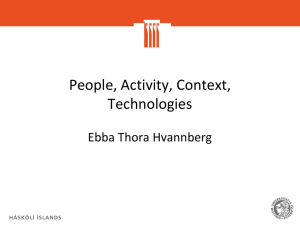

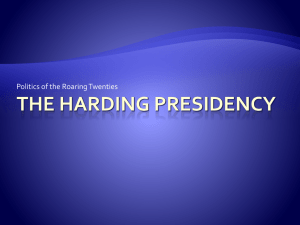




![Best-fit Decisions [, 25 KB]](http://s3.studylib.net/store/data/006613263_1-62a61f810693250e9828b38f77c693b2-300x300.png)
